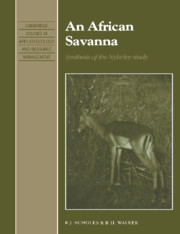Book contents
- Frontmatter
- Contents
- Preface
- I Nylsvley in an African savanna context
- 1 African savannas: an overview
- 2 The people of Nylsvley
- 3 The climate at Nylsvley
- 4 Geology, landform and soils
- 5 The Nylsvley biota
- II The key determinants: water, nutrients, fire and herbivory
- III The carbon cycle
- IV Community and landscape pattern and change
- Part V Lessons from Nylsvley
- Bibliography
- Index
5 - The Nylsvley biota
Published online by Cambridge University Press: 06 October 2009
- Frontmatter
- Contents
- Preface
- I Nylsvley in an African savanna context
- 1 African savannas: an overview
- 2 The people of Nylsvley
- 3 The climate at Nylsvley
- 4 Geology, landform and soils
- 5 The Nylsvley biota
- II The key determinants: water, nutrients, fire and herbivory
- III The carbon cycle
- IV Community and landscape pattern and change
- Part V Lessons from Nylsvley
- Bibliography
- Index
Summary
Savannas are not generally regarded as especially diverse ecosystems, but in many instances they have a species richness well above the global average. The Nylsvley Nature Reserve includes, in an area of 3120 ha, over 600 plant species, 325 bird species, 67 mammal species, a large but unknown number of insect species (including at least 194 butterflies, hawk moths and emperor moths, 60 grasshoppers, 21 termites, and 78 dung-associated beetles), 18 amphibian species and 54 reptile species (Table 5.1). The biodiversity found in this small savanna reserve compares favourably with that of entire regions in Northern temperate biomes. The species diversity at Nylsvley is attributable to three factors: the diversity of habitats represented there; the climatic, geomorphological and biogeographical history of the region; and the long period of evolutionary development, uninterrupted by catastrophic events such as glaciations.
Nylsvley lies at the intersection of three rather different geological formations. This, coupled with the local land-form, leads to five distinct soil groups. Within each of these are variations of soil depth, water regime and fertility. Seven discrete plant communities occupy the broad soil groups, with 12 community variations and 4 subvariations (Coetzee et al. 1976; Figure 5.1 is a slightly modified map of their distribution). Superimposed on this soil–vegetation mosaic are a number of disturbances such as fire, grazing and burrowing animals and windfalls, which lead to temporary microenvironments with specific attributes. Three further ‘secondary’ plant communities are recognised on old fields and settlement sites.
- Type
- Chapter
- Information
- An African SavannaSynthesis of the Nylsvley Study, pp. 43 - 56Publisher: Cambridge University PressPrint publication year: 1993



